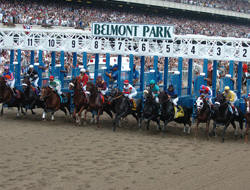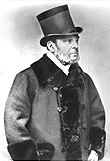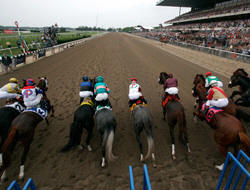 Welcome to the 2025
Belmont Stakes. We trust you enjoy the
races and find something useful on our website.
Welcome to the 2025
Belmont Stakes. We trust you enjoy the
races and find something useful on our website.
YES. It HAPPENED. Justify and Mike Smith become Triple Crown Champions - the 13th in over a century! With a winning time of 2:28.18, Justify won handily wire to wire. Thanking Jesus Christ, after the race, Mike Smith became the oldest winner of the Triple Crown. Big Money Mike has been riding before he could walk! He is a humble man and a super athlete. And we congratulation him, Bob Baffert and all the connections of Justify!
Justify handily won the Kentucky Derby. Concerns over a bruise proved to be nothing when Bob Baffert sent the plucky colt out to to Pimlico and what proved to be a muddy and FOGGY Preakness Stakes. In fact, you may have wondered if your TV had problems as the fog was so thick that it was difficult to see the horses! In the end, Justify triumphed and is one of 36 horses to lay claim to winning the Kentucky Derby and Preakness Stakes.
In 2015, history was made when we witnessed a Triple Crown victory by American Pharoah and Victor Espinoza.
In 2014 we saw Victor Espinoza ride California Chrome in what many hoped to be end to the Triple Crown drought. However, much like the brown and burnt lawns in California, Victor and and California Chrome came up dry and couldn't manage to make it rain; and once again, fans were let slack-jawed with what might have been.
In 2014, California finished a disheartening 4th place to the winner Tonalist. There is a list of infamy for horses who were eligible to win the Triple Crown but then did not manage to win-- the horses who won the Kentucky Derby and Preakness Stakes but who lost the Belmont Stakes. Thankfully, American Pharoah's name was not to be added to this list and instead both Espinoza and AP become immortal and ended the break in Triple Crown victory's since 1978 when Affirmed won.
Where is the Belmont Stakes?
Belmont
Park in Elmont, New York.
When is the Belmont Stakes?
Saturday, June 7th, 2025
Because of its distance and status as the race that can make or break a Triple Crown champion, the Belmont Stakes has been the venue for some of the most famous moments in American racing.
Quick Facts:
Main Course: 1 1/2 Miles
Last Turn to Finish on Main Track: 1,097 feet
Widener Turf Course: 1 5/16 Miles
Inner Turf Course: 1 3/16 Miles
Attendance Capacity: 85,000 - 90,000
Parking Capacity: 18,500 Cars
Trackside Dining: 2,300
Total Seating Capacity: 32,941
 The
Belmont Stakes, the final and most demanding leg of the Triple
Crown, is named after August Belmont who had been a leading
banker and racing man of the 19th century. He was also the first
President of the Jockey Club in 1867. In 1869, August Belmont
took first and second money with his own Fenian and Glenelg.
The
Belmont Stakes, the final and most demanding leg of the Triple
Crown, is named after August Belmont who had been a leading
banker and racing man of the 19th century. He was also the first
President of the Jockey Club in 1867. In 1869, August Belmont
took first and second money with his own Fenian and Glenelg.
 In 1985, trainer Woody Stephens
saddled the entry of Creme Fraiche and Stephan's Odyssey to
finish one-two and in doing so, clinched his record-breaking
fourth consecutive Belmont. Creme Fraiche thus became the first
gelding to win the classic Belmont Stakes. Woody Stephens was
back in 1986 with another Belmont charge, Danzig Connection, who
went on to win the Belmont, giving Stephens his fifth
consecutive Belmont Stakes victory. Trainer D. Wayne Lukas would
notch his third consecutive Belmont win in 1996, with Editor's
Note.
In 1985, trainer Woody Stephens
saddled the entry of Creme Fraiche and Stephan's Odyssey to
finish one-two and in doing so, clinched his record-breaking
fourth consecutive Belmont. Creme Fraiche thus became the first
gelding to win the classic Belmont Stakes. Woody Stephens was
back in 1986 with another Belmont charge, Danzig Connection, who
went on to win the Belmont, giving Stephens his fifth
consecutive Belmont Stakes victory. Trainer D. Wayne Lukas would
notch his third consecutive Belmont win in 1996, with Editor's
Note.
In 1993, Julie Krone became the first female jockey to ever win a Triple Crown race, when she guided Colonial Affair to victory.
The Belmont Stakes was run at Jerome Park from l867 to l889; at Morris Park from l890 to l904; at Aqueduct from l963 to l967. Not run in l9ll and l9l2. Run at a mile and five furlongs from l867 to l873; a mile and a quarter in l890, l89l, l892, l895, l904 and l905; a mile and a furlong in l893 and l894; a mile and three furlongs from l896 to l903 and from l906 to l925. No time taken in l907 and l908. Run as a Handicap Stakes in 1895 and in 1913. The value for the 1987, 1988, and 1992 winners includes the $1,000,000 Triple Crown point system bonus.
Secretariat's amazing 31-length victory in the 1973 Belmont Stakes established the world record for a mile and a half at 2:24. With his win in the Belmont, he became the ninth horse to capture the Triple Crown.
Twenty-six horses have been eligible to win the Triple Crown coming into the Belmont Stakes and eleven have succeeded. In the last three runnings, horses that won the Kentucky Derby and Preakness (Silver Charm, Real Quiet, and Charismatic) were denied racing immortality in the Belmont Stakes. Racing has not seen a Triple Crown champion since 1978, when Affirmed swept the three-race series.
A crowd of 85,818, the largest in New York Racing history, attended the 1999 running, hoping to see Charismatic become Racing's 12th Triple Crown winner. Unfortunately, during the stretch run, the colt suffered a condylar and sesamoid bone fracture in his left foreleg, and finished third.
Over the years we have seem triumph and defeat with suprise finishes. Who can forget Big Brown -- favored to crush the field-- finish his Triple Crown in last place. In 2009, we witnessed Summer Bird triumph over his kin-- Mine That Bird.
Brief History of the Belmont Stakes
The first Belmont in the United States was not the famous stakes race or even
the man for whom it is named. Rather, the first Belmont was a race horse that
arrived in California in 1853 from his breeding grounds of Franklin, Ohio. The
Belmont Stakes, however, are named after August Belmont, a financier who made
quite a name and fortune for himself in New York politics and society.
Obviously, Mr. Belmont was also quite involved in horse racing, and his imprint
is even intertwined within the history of the Kentucky Derby.
More History of the Belmont Stakes. .
.
Some Monumental Belmont Moments
In 1890, the Belmont was moved from Jerome Park to Morris Park, a mile and
three-eighths track located a few miles east of what is now Van Cortlandt Park
in the Bronx. The Belmont was held at Morris Park until Belmont Park's opening
in 1905.
Here's a tidbit you didn't see in Derby or Preakness history. When Grey Lag won
the Belmont in 1921, it marked the first running of the Belmont Stakes in the
counter-clockwise manner of American fashion. This 53rd running was a mile and
three-eighths over the main course; previous editions at Belmont Park had been
run clockwise, in accordance with English custom, over a fish-hook course which
included part of the training track and the main dirt oval.
The first post parade in this country came in the 14th running of the Belmont in
1880. Until then the horses went directly from paddock to post.
The Belmont has been run at various distances. From 1867 tp 1873 it was 1 5/8
miles; from 1874 to 1889 it was 1 1/2 miles; from 1890 through 1892, and in
1895, it was held at 1 1/4 miles; from 1896 through 1925 it was 1 5/8 miles;
since 1925 the Belmont Stakes has been a race of 1 1/2 miles.
Champion Sires
A total of eleven Belmont Stakes winners have sired at least one
other Belmont winner.
Man o' War heads the list of Belmont champion sires. Not only did he win the
race himself in 1920, but three of his subsequent sires won it as well: American
Flag in 1925, Crusader in 1926 and War Admiral in 1937, who went on to win the
Triple Crown.
Commando won the 1901 running, then sired Peter Pan, the 1907 champ and the
Colin, the 1908 winner.
1930 champion Gallant Fox sired both Omaha (1935) and Granville (1936).
Count Fleet won the 1943 edition, and then sired back-to-back Belmont winners
with Counterpoint (1951) and One Count (1952).
1977 Triple Crown winner Seattle Slew sired a Call To The Derby Post favorite in
Swale, who won both the Derby and the Belmont in 1984, as well as A.P. Indy, who
won the Belmont in 1992. 1999 Belmont winner Lemon Drop Kid is also a descendant
of the Slew.
The following horses have sired one Belmont winner each: Duke of Magenta of 1878
sired Eric (1889); Spendthrift of 1879 sired Hastings (1896); Hastings then
followed his again by siring Masterman, the 1902 winner. The Finn of 1915 sired
Zev (1923); Sword Dancer of 1959 sired Damascus (1967); last but not least,
Triple Crown winner Secretariat of 1973 sired Risen Star, the 1988 winner.
